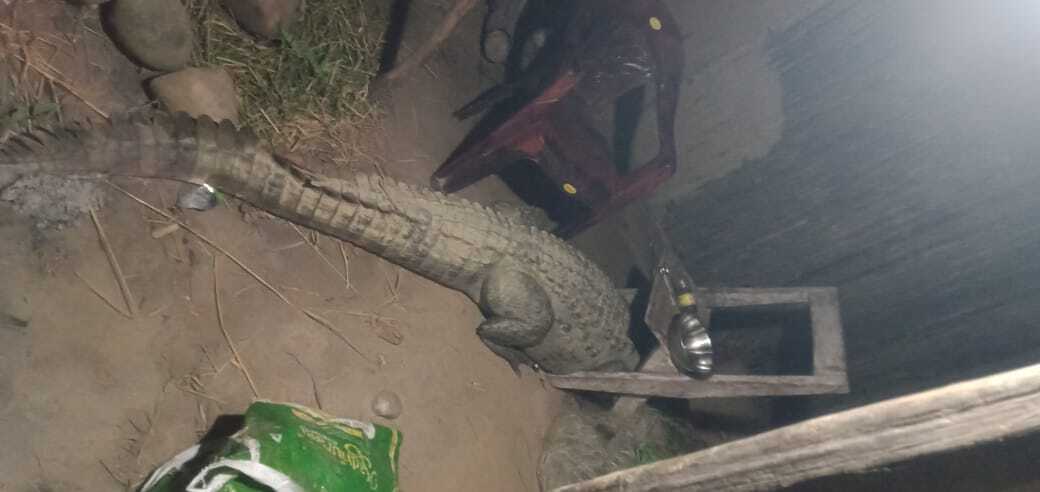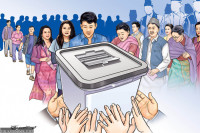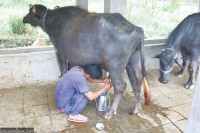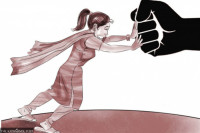National
Crocodiles and pythons add to tiger and elephant threat to Chitwan park buffer zone residents
In the past five months, Chitwan National Park recorded 199 animal rescues including 129 mugger crocodiles.
Ramesh Kumar Paudel
When Bimala Bote of Ratnanagar Municipality in Chitwan stepped out of her mud house at around midnight on November 21, she went to check on some noise that sounded like an animal dragging something in the dark. What she did not expect was to come face-to-face with a full-grown mugger crocodile, just a few metres from where her three-year-old daughter and husband were sleeping.
“I had never seen a mugger crocodile this close in my life. I am from Ramechhap—there are no animals like this in our village,” Bote recalled, describing how she froze when her phone’s flashlight shone on the crocodile. The crocodile had reached her yard after crawling up from the Rapti river, which flows barely 300 metres from her home. Since that night, she has hardly slept. “With a small child in the house, how can anyone sleep after seeing a crocodile just outside the door?” she lamented.
Encounters with wild animals in settlements near Chitwan National Park are not new. For decades, communities living around the park have dealt with elephants breaking walls, rhinos raiding fields, tigers occasionally attacking livestock as well as people, and deer, monkeys and wild boars damaging crops. But in recent years, a different group of animals—reptiles such as mugger crocodiles, pythons, rat snakes and king cobras—have begun troubling riverside settlements more frequently.
According to Chitwan National Park officials, most wildlife rescue cases registered in the past few months involve reptiles rather than big mammals. The park’s Information and Conservation Officer Abinash Thapa Magar said that the problem has grown significantly.
“From mid-July to mid-November alone, we rescued 199 animals, and the highest number among them were mugger crocodiles,” he said. Of the 199 rescues, 129 were mugger crocodiles, followed by 52 pythons, two king cobras, four rat snakes, six turtles and a few monkeys and deer.

The increase in reptile movement has become a safety concern for residents. In Bote’s case, the animal fled towards the river before the park staff could trap it. She said she first informed local leader Pradeep Bote of the Nepal Bote Society. The incident was reported to the park office at around 1:30 am, and a rescue team arrived within half an hour, but the crocodile had already slipped away. “We are terrified. If a crocodile can reach the sleeping space of a house, how can we feel safe?” she asked.
Chitwan National Park, the country’s first protected area, is home to two major crocodile species—the critically endangered gharial and the more aggressive mugger crocodile. While gharials are shy, fish-eating reptiles that prefer clean, deep rivers and rarely come close to human settlements, mugger crocodiles are versatile and opportunistic. Muggers thrive in lakes, rivers, ponds, and wetlands and are known to move several kilometres overland in search of food. Mugger crocodiles have even been found in hotel swimming pools and fish ponds, leading to frequent emergency rescues.
“When muggers reach settlements, they mostly target poultry, fish ponds, or domestic animals,” Thapa Magar said. There have also been cases of fatal human-wildlife encounters when people unexpectedly meet crocodiles while collecting water or working near rivers.
Pythons, meanwhile, are most frequently captured from chicken coops. According to the park’s officials, the rescuers often get calls late at night when villagers find a python wrapped around their chickens. Compared to muggers, rescuing pythons is easier, but the increasing number of sightings close to homes indicates changing wildlife behaviour and shrinking space for animals.
Park officials say that crocodile rescues are the most challenging. Thapa Magar said the animals have been recorded travelling up to two or three kilometres from rivers or ponds. “Rescuing them requires strong nets, technical skill, trained staff and alert communities,” he said. “We are upgrading our rescue equipment, but communities also need awareness about how to stay safe.”
Researchers studying human-wildlife conflict in Chitwan have previously noted that the expansion of settlements, rapid tourism growth, riverbank erosion, loss of wetland space, and seasonal flooding all contribute to increased encounters. Improvements in conservation—such as reduced poaching and habitat protection—have also helped wildlife populations rebound, bringing more animals into closer contact with people.
For families like the Botes, the fear persists long after the rescue teams have left. Bimala, whose husband works as a daily wage labourer and spends most evenings exhausted from fieldwork, said the experience has changed how the family lives. “Before, we slept peacefully. Now, every night I wake up to listen for sounds outside. Every rustle makes me afraid that the crocodile has returned,” she said.
Local residents and park staff agree that with the rising cases of reptile movement, awareness is now as important as rescue operations. “A mugger crocodile is dangerous. People need to understand how to avoid confrontations and when to call authorities,” emphasised Thapa Magar.




 10.12°C Kathmandu
10.12°C Kathmandu1.jpg)















